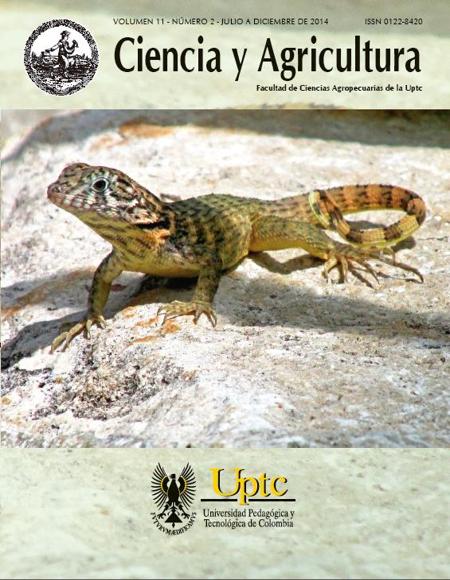In vitro effect of yeast preparations on ruminal methane production

Abstract
The aim of this study was to evaluate the effect, in vitro, of Saccharomyces cerevisiae and Levica -25 preparations, viables on ruminal methanogens and methanogenesis. Three treatments were compared: C) Cynodon nlemfuensis (Star grass) as control; S) C. nlemfuensis + S. cerevisiae; and L) Levica 25 + C. nlemfuensis, all with rumen fluid from adult male buffalo. The treatments were evaluated using standard laboratory techniques for microbiological and fermentation indicators at 8, 12 and 24 hours of fermentation, under completely randomized design with 3x3 bifactorial arrangement (3 treatments with 3 sampling times), with 4 replicates for each treatment, and a total of 36 experimental units represented by glass bottles of 100 mL each. We observed statistical differences (P =< 0.01) between treatments and between times assessed for the following indicators: methanogens population, methane gas production, cellulolytic bacteria, total viable bacteria, protozoa and pH. Yeast as a supplement in ruminants diet improves the food usage, increasing the cellulolytic bacteria population and decreasing the methanogenic bacteria population and enteric gas, which is an interesting contribution for mitigation environmental pollution. The yeast Levica -25 was more efficient. We recommend using Saccharomyces cerevisiae and Levica -25 preparations in large ruminants to decrease methanogenesis in the rumen and increase the population of cellulolytic bacteria.Keywords
cellulolytic, yeast, methanogenesis, methanogenic, ruminal.
References
- Johnson D.E., Johnson K.A., Ward G.M. & Branine M.E. Ruminants and other animals. Chapter 8. En: Atmospheric Methane: Its Role in the Global Environment. Eds. M.A.K. Khalil, Springer-Verlag, Berlin Heidelberg. Germany. 2000.
- Beauchemin K.A. & McGinn S.M. Methane emissions from feedlot cattle fed barley or corn diets. J. Anim. Sci., 2005; 83: 653.
- Gil S.B. Sistema de producción de carne bovina: Engorde intensivo. Elementos que intervienen y posibles impactos en el medio ambiente. Buenos Aires, Argentina, 2004.
- Anderson R.C., Callaway T.R., van Kessel J.A.S., Jung Y.S., Edrington T.S. & Nisbet D.J. Effect of select nitro compounds on ruminal fermentation; an initial look at their potential to reduce economic and environmental costs associated with ruminal methanogenesis. Bioresource Technol, 2003; 90: 59.
- Marrero Y. Las levaduras como mejoradoras de la fermentación ruminal de dietas con alto contenido de fibra. Tesis de Doctorado en Ciencias Veterinarias. Instituto de Ciencia Animal. La Habana. Cuba, 2005.
- Demeyer D.L. & fievez V. Ruminants et environnement: la méthanogenèse. Ann. Zootech, 2000; 49: 95.
- Theodorou M.K, Williams B.A., Dhanoa M.S., Mcallan A.B. & France J. A simple gas production method using a pressure transducer to determine the fermentation kinetics of ruminants feed. Anim. Feed. Sci. Tech, 1994; 48: 185.
- Hungate R. G. The anaerobic, mesophilic cellulolitic bacteria. Bacterial, 1970; 112.
- Caldwell D. R. & Bryant M.P. Medium without fluid for non selective enumeration and isolation of rumen bacteria. Appl. Microbiol, 1966; 1134.
- Galindo J. Efecto de la zeolita en la población de bacterias celulolíticas y su actividad en vacas que consumen ensilaje. Tesis Ph.D. Instituto de Ciencia Animal, La Habana, Cuba, 1988.
- Kamra D.N., Chaudhary L.C., Neeta-Agarwal, Singh R., Pathak N.N. & Agarwal N. Growth performance, nutrient utilization, rumen fermentation and enzyme activities in calves fed on Saccharomyces cerevisiae supplemented Diet. Indian-J. Animal-Sci., 2002; 72: 472.
- Rodríguez T. Estudio del efecto del aceite esencial de orégano de monte (Lippia origanoides) del Alto Patía sobre la metanogénesis y la actividad fibrolítica del ecosistema ruminal. Tesis Doctoral. Universidad Nacional de Colombia. Bogotá. 2014.
- Thauer R. K. & Shima S. Biogeochemistry: Methane and microbes, Nature, 2006; 440: 878.
- Beauchemin K.A. Kreuzer M., Mara O. & McAllister. Nutritional management for enteric methane abatement’s review. Australian J. Experimental Agric., 2008; 48: 21.
- Orpin C. The role of ciliate protozoa and fungi in the rumen digestion of plant cell walls. Anim. Feed Sci. Technol, 1983; 10: 121-143.
- Dawson K.A. & Girard I.D. Biochemical and physiological basis for the stimulatory effects of yeast preperations on ruminal bacteria. En: Biotechnology in the Feed Industry. Eds. T.P. Lyons & K.A. Jacques. Nottingham University Press, Nottingham, UK. 997.
- Marrero Y., Galindo J., Torres V., Rodríguez Z., Álvarez E., Aldana A.I. et al. Avances en el estudio de las levaduras como activadoras de la fermentación ruminal en bovinos que consumen dietas fibrosas. Revista de Ciencia y Tecnología de la UACJ, 2008; 6: 93.
- Carro M.D. & Ranilla M.J. Los aditivos antibióticos promotores del crecimiento de los animales: situación actual y posibles alternativas, 2002. Disponible en: www.exopol.com.
- Agarwal N., Kamra D.E., Chatterjee P.N., Kumar R. & Chaudhary L.C. In vitro methanogenesis, microbial profile and fermentation of green forages with buffalo rumen liquor as influenced by 2 bromoethanesulphonic acid. Asian Austr. J. Anim. Sci., 2008; 21: 818.
- González N. Evaluación de morera (Morus alba Lin) en la fermentación y control de la metanogénesis ruminal de búfalos de río (Bubalus bubalis). Tesis de Doctorado. Instituto de Ciencia Animal, Mayabeque, Cuba. 2010.
- Galindo J., González N. & Delgado D. Los árboles como controladores de los metanógenos y producción de metano en el rumen. II Taller Internacional Salud y Producción Animal-II Congreso Cubano de Desarrollo Local. Granma, Cuba. 2009.
- Joblin K.N. Methanogenic Archaea. En: I Planning Meeting of Project Contract Research and Training Workshop Development and Use of Rumen Molecular Techniques for Predicting and Enhancing Productivity”. Brisbane. 2004.
- Makkar H.P.S. In vitro gas method for evaluation of feed containing phychemicals. Anim. Feed. Sci. Technol, 2005; 123: 291.
- Galindo J., González N., Scull I., Marrero Y., Sosa A., Aldana A.I. et al. Effect of Samanea saman, (Jacq.) Merr, Albizia lebbeck Benth and Tithonia diversifolia (Hemsl.) Gray (plant material 23) In the methanogen population and on the ruminal microbial cology. Cuban J. Agric. Sci., 2012; 46: 273.
Downloads
Download data is not yet available.